Our Relationship to Water and Experience of Water Insecurity among Apsáalooke (Crow Indian) People, Montana
Abstract
1. Introduction
…food security, ceremonial use, knowledge transmission, and community cohesion all play primary roles in Swinomish definitions of individual and community health and complement physical indicators of health. Thus, to eat less seafood (as prescribed on the basis of current physiological measures) may actually be detrimental to the Swinomish concept of health…
2. Crow Reservation
3. Materials and Methods
3.1. Participants and Data Collection
3.2. Qualitative Data Analysis
4. Results
4.1. Water is Sacred
Well, in the spring, when the water has flooded and it starts going down, we feed the water [to protect our children]. Our kids are safe, they play, our kids, they play at the river all day. And then we would have the Sundance, and then we give water to people in mourning, and we have a lot of uses for water. We’re always praying over water […] we want to pray over water and then give it to those [ill] people, so they feel better…
I grew up at the river and I was always there. The Little Bighorn River is right there, a few feet away from my house […] We were always playing at the river. And then in the winter when it freezes over, we skate there too […] We always said we were raised by the river, the Little Bighorn River right there.
4.2. Causes of Change
Everything has changed now, with different people moving in. I mean when the old ranchers used to have this place, they never sprayed their crops, not like they do now. And of course, they use irrigation through the year, and I do not know whether it is the chemicals or what that is making the water worse here.
4.3. Health Risks associated with Water Quality Changes
We used to fetch water right over here, me and my brothers would come home with pails and haul water back for drinking. That’s what we lived on, then when we built the big house, we had running water and my dad always drank it, but I always thought he maybe died from that because he died of cancer. It could be the hard water because the taps are orange colored and rust colored. We drank water from the river, and he drank right off the spout and he always thought it was good water, but he died of pancreatic cancer and I always wondered if it was connected or related.
I can’t think of anybody that got sick from the water here, from the river or from the well water that we drink. My mom’s house that I grew up in was also well water, and that one is rusty. It’s really hard water, and I grew up drinking it and we always drank it and our babies drank it. Um, we mix their formulas with it, and nobody ever got sick that I can remember.
Horses and the cows cross over it [river], but they don’t stay in the water, and there’s rocks, a lot of rocks, and there’s the water’s running all the time, so it’s pretty clean. But we drink that river during the [sweat lodges] or [Native American Church] meetings. We don’t get sick. And it’s pretty clean around where I live. But upstream, I don’t know. Must be ok because we never got sick.
4.4. Resulting Changes in Water Use (Sense of Loss)
As I become more aware of what’s in that water, I’ve really curtailed my use of it. You know, I was thinking about it this morning, all of my life, from the time I was a little kid, that river played an important part of our life. Every bit of the fish that we caught out of there we ate. It wasn’t like we were looking for a large fish or a trophy fish or a specific type a fish. All that fish came out, my dad would take it home and my mom would cook it, and there would be a plate of mixed fish on the table…That was our food. And so, now I don’t fish anymore […] And that was something I enjoyed doing […] and I think I relayed that story to you where I got a number of catfish one time, and every one of them had sores on their body. And I had never, ever seen that in my life. And that told me right there, something was going on with that river that I had never seen. And so, you know that was a big deterrent to me.
When I lived down there […] when I was a teenager, always they would get the drinking water right out of the river. And that was on the counter there, a bucket with a dipper, [they] would open that hole up in the ice and dip water out of there, and that was just the drinking water […] Nobody gave it a second thought […] You know. But I know that wouldn’t happen now. They preferred the river water over the well water, because the well water had that funny taste to it.
4.5. Water Insecurity
We have to pre-pay before they deliver the water. We mostly use the water from the cistern to shower, washing dishes, and flushing the toilet. We have two five-gallon water jugs on reserve just in case they don’t deliver the water right away. For our drinking water, I buy the bottled water. I buy about four of the 24 in a case. It lasts about a month. It costs about $20. For cooking, I have a water cooler that contains a five-gallon jug [...] That costs about $5. If I add it all up in the month $215 a month.
It’s really bad […] I’d like to have some something done for us. Get some water so we can drink it from the house. And, I don’t have to buy water all the time […] Everything’s just bad at the house. That water. Can’t even wash, can’t even do anything with it.
4.6. Dealing with Change
Little Big Horn College’s program came and did testing on it. There were bacteria in there. I had to have [the well] shock chlorinated and there were still bacteria in there and that is why I had to turn to buy bottled water for drinking and cooking with. I don’t know how it is today. I probably still have to shock chlorinate it to get rid of that. I did get sick from drinking my water. When we first moved in, the house water had a lot of iron in it. I had to put in a water softener, and it helped, and it was ok. Until maybe within the last three years we quit drinking it after we found out I had ulcers from the bacteria in there.
4.7. Solutions are Hard to Find
And they only drill until they hit first water and that’s as far as they go. We were told when we had our well done here that they were going to dig, do four different tests, and they would tell us what the results were. And they did samples of how far down it was, and they took samples of soil, and the water and didn’t even take them. They didn’t test them, I kept complaining kept complaining and so far, nothing has been done. And like I said you know it’s something they do for us, but yet at the same time they don’t do it right…
I know in Lodge Grass they always tested it, and my sister worked there so I always knew that it was safe, but other than that I don’t know how it is now. And here in Hardin, they never send any letters saying that they tested the water or anything. I assume you know that they do. It hasn’t tasted any different.
Well, we don’t know that for sure, we don’t know if it’s because this flood is right here in Wyola and I don’t know for some reason we were told up here, we are about seven miles towards the Little Bighorn [river], towards the mountains, and we were told we weren’t supposed to use the water. As far as I know it’s the same water that flows here in the Little Bighorn that’s in town there, they’re getting but we feel that for some reason it’s safer […] I know that we were told not to use it, so far we have been kind of taking their advice and getting all our water down in Wyola from families.
4.8. Availability of Resources
These guys were trying to actually improve the drinking the water, then they did the study and found out the city pipes were bad. It was the water quality group here that has been testing it. They even tested the water down by our river. They tested our house water and said for the most part it was ok.
Because of our cattle in the winter they are in our pasture and I think the manure seeps into it, and they tested before and they told us not to drink it, so we buy our own water. I think they need to test it again.
5. Discussion
6. Conclusions
Supplementary Materials
Author Contributions
Funding
Institutional Review Board Statement
Informed Consent Statement
Data Availability Statement
Acknowledgments
Conflicts of Interest
References
- Levin, R.; Epstein, P.R.; Ford, T.E.; Harrington, W.; Olson, E.; Reichard, E.G. U.S. drinking water challenges in the twenty-first century. Environ. Health Perspect. 2002, 110, 43–52. [Google Scholar] [CrossRef] [PubMed]
- VanDerslice, J. Drinking water infrastructure and environmental disparities: Evidence and methodological considerations. Am. J. Public Health 2011, 101, S109–S114. [Google Scholar] [CrossRef] [PubMed]
- Benedict, K.; Reses, H.; Vigar, M.; Roth, D.M.; Roberts, V.A.; Mattioli, M.; Cooley, L.A.; Hilborn, E.D.; Wade, T.J.; Fullerton, K.E.; et al. Surveillance for Waterborne Disease Outbreaks Associated with Drinking Water—United States, 2013–2014. MMWR Morb. Mortal. Wkly. Rep. 2017, 66, 1216–1221. [Google Scholar] [CrossRef] [PubMed]
- Schimpf, C.; Cude, C. A Systematic Literature Review on Water Insecurity from an Oregon Public Health Perspective. Int. J. Environ. Res. Public Health 2020, 17, 1122. [Google Scholar] [CrossRef]
- United Nations. Sustainable Development Goals. Goal 6: Ensure Access to Water and Sanitation for All. Available online: https://www.un.org/sustainabledevelopment/water-and-sanitation/ (accessed on 25 October 2020).
- Goddard, J.J. Measuring Drinking Water Affordability and Sustainability. Ph.D. Thesis, University of California, Berkeley, CA, USA, 2019. [Google Scholar]
- Jepson, W.; Budds, J.; Eichelberger, L.; Harris, L.M.; Norman, E.; O’Reilly, K.; Pearson, A.; Shah, S.; Shinn, J.; Staddon, C.; et al. Advancing human capabilities for water security: A relational approach. Water Secur. 2017, 1, 46–52. [Google Scholar] [CrossRef]
- Williams, M.K.; Murthy, S. Report on the October 25, 2011 Roundtable Meeting with the UN Special Rapporteur on the Human Right to Safe Drinking Water and Sanitation, Catarina De Albuquerque. Available online: https://papers.ssrn.com/sol3/papers.cfm?abstract_id=2442020 (accessed on 9 January 2021).
- Sullivan, C.A.; Meigh, J.R.; Giacomello, A.M. The water poverty index: Development and application at the community scale. Nat. Resour. Forum 2003, 27, 189–199. [Google Scholar] [CrossRef]
- Korc, M.E.; Ford, P.B. Application of the Water Poverty Index in border colonias of west Texas. Water Policy 2013, 15, 79–97. [Google Scholar] [CrossRef]
- Balazs, C.L.; Ray, I. The drinking water disparities framework: On the origins and persistence of inequities in exposure. Am. J. Public Health 2014, 104, 603–611. [Google Scholar] [CrossRef]
- Firestone, L.; Kaswan, A.; Meraz, S. Environmental justice: Access to clean drinking water. Hastings Law J. 2006, 57, 1367. [Google Scholar]
- Riggs, E.; Hughes, J.; Irvin, D.; Leopard, K. An Overview of Clean Water Access Challenges in the United States; Global Water Challenge and the Environmental Finance Center/University of North Carolina: Chapel Hill, NC, USA, 2017. [Google Scholar]
- Wilson, S.M.; Heaney, C.D.; Cooper, J.; Wilson, O. Built Environment Issues in Unserved and Underserved African-American Neighborhoods in North Carolina. Environ. Justice 2008, 1, 63–72. [Google Scholar] [CrossRef]
- Wilson, S.M.; Heaney, C.D.; Wilson, O. Governance Structures and the Lack of Basic Amenities: Can Community Engagement Be Effectively Used to Address Environmental Injustice in Underserved Black Communities? Environ. Justice 2010, 3, 125–133. [Google Scholar] [CrossRef]
- US Water Alliance. An Equitable Water Future: A National Briefing Paper; US Water Alliance: Washington, DC, USA, 2017. [Google Scholar]
- U.S. Environmental Protection Agency. Infrastructure Task Force to Improve Access to Safe. Drinking Water and Basic Sanitation in Indian Country. 2013. Available online: http://www.epa.gov/tribal/trprograms/infra-water.htm (accessed on 3 March 2014).
- Charrois, J.W. Private drinking water supplies: Challenges for public health. Can. Med Assoc. J. 2010, 182, 1061–1064. [Google Scholar] [CrossRef] [PubMed]
- DeSimone, L.A.; Hamilton, P.A.; Gilliom, R.J. Quality of Water from Domestic Wells in Principal Aquifers of the United States, 1991–2004; US Department of the Interior/US Geological Survey: Reston, VA, USA, 2009. [Google Scholar]
- Centers for Disease Control and Prevention. Keeping Water Safe for the Navajo Nation; Centers for Disease Control Prevention: Atlanta, GA, USA, 2008.
- Hoover, J.; Gonzales, M.; Shuey, C.; Barney, Y.; Lewis, J. Elevated Arsenic and Uranium Concentrations in Unregulated Water Sources on the Navajo Nation, USA. Expo. Health 2017, 9, 113–124. [Google Scholar] [CrossRef]
- Jones, M.C.; Credo, J.; Ingram, J.C.; Baldwin, J.A.; Trotter, R.T., Jr.; Propper, C.R. Arsenic Concentrations in Ground and Surface Waters across Arizona Including Native Lands. J. Contemp. Water Res. Educ. 2020, 169, 44–60. [Google Scholar] [CrossRef]
- Eggers, M.J.; Doyle, J.T.; Lefthand, M.J.; Young, S.L.; Moore-Nall, A.L.; Kindness, L.; Roberta Other Medicine; Ford, T.E.; Dietrich, E.; Parker, A.E.; et al. Community Engaged Cumulative Risk Assessment of Exposure to Inorganic Well Water Contaminants, Crow Reservation, Montana. Int. J. Environ. Res. Public Health 2018, 15, 76. [Google Scholar] [CrossRef]
- Cozzetto, K.; Chief, K.; Dittmer, K.; Brubaker, M.; Gough, R.; Souza, K.; Ettawageshik, F.; Wotkyns, S.; Opitz-Stapleton, S.; Duren, S.; et al. Climate change impacts on the water resources of American Indians and Alaska Natives in the US. In Climate Change and Indigenous Peoples in the United States; Springer: Heidelberg, Germany, 2013; pp. 61–76. [Google Scholar]
- Donatuto, J.L.; Satterfield, T.A.; Gregory, R. Poisoning the body to nourish the soul: Prioritising health risks and impacts in a Native American community. Health Risk Soc. 2011, 13, 103–127. [Google Scholar] [CrossRef]
- Hanrahan, M.; Sarkar, A.; Hudson, A. Water insecurity in Indigenous Canada: A community-based inter-disciplinary approach. Water Qual. Res. J. 2015, 51, 270–281. [Google Scholar] [CrossRef]
- Wilson, N.J.; Harris, L.M.; Joseph-Rear, A.; Beaumont, J.; Satterfield, T. Water is medicine: Reimagining water security through Tr’ondëk Hwëch’in relationships to treated and traditional water sources in Yukon, Canada. Water 2019, 11, 624. [Google Scholar] [CrossRef]
- Awume, O.; Patrick, R.J.; Baijius, W. Indigenous Perspectives on Water Security in Saskatchewan, Canada. Water 2020, 12, 810. [Google Scholar] [CrossRef]
- Mitchell, F.M. Water (in)security and American Indian health: Social and environmental justice implications for policy, practice, and research. Public Health 2019, 176, 98–105. [Google Scholar] [CrossRef]
- Ellis, R.; Perry, D. A confluence of anticolonial pathways for indigenous sacred site protection. J. Contemp. Water Res. Educ. 2020, 169, 8–26. [Google Scholar] [CrossRef]
- Cummins, C.; Doyle, J.; Kindness, L.; Lefthand, M.J.; Bear Don’t Walk, U.J.; Bends, A.; Broadaway, S.C.; Camper, A.K.; Fitch, R.; Ford, T.E.; et al. Community-based participatory research in Indian country: Improving health through water quality research and awareness. Fam. Community Health 2010, 33, 166. [Google Scholar] [CrossRef] [PubMed]
- Doyle, J.T.; Redsteer, M.H.; Eggers, M.J. Exploring effects of climate change on Northern Plains American Indian health. In Climate Change and Indigenous Peoples in the United States; Springer: Heidelberg, Germany, 2013; pp. 135–147. [Google Scholar]
- Eggers, M.J.; Moore-Nall, A.L.; Doyle, J.T.; Lefthand, M.J.; Young, S.L.; Bends, A.L.; Crow Environmental Health Steering Committee; Camper, A.K. Potential Health Risks from Uranium in Home Well Water: An Investigation by the Apsaalooke (Crow) Tribal Research Group. Geosciences 2015, 5, 67–94. [Google Scholar] [CrossRef]
- Hamner, S.; Broadaway, S.C.; Berg, E.; Stettner, S.; Pyle, B.H.; Man, N.B.; Elk, J.O.; Eggers, M.J.; Doyle, J.; Kindness, L.; et al. Detection and source tracking of Escherichia coli, harboring intimin and Shiga toxin genes, isolated from the Little Bighorn River, Montana. Int. J. Environ. Health Res. 2013, 24, 341–362. [Google Scholar] [CrossRef] [PubMed]
- Hamner, S.; Brown, B.L.; Hasan, N.A.; Franklin, M.J.; Doyle, J.T.; Eggers, M.J.; Colwell, R.R.; Ford, T.E. Metagenomic Profiling of Microbial Pathogens in the Little Bighorn River, Montana. Int. J. Environ. Res. Public Health 2019, 16, 1097. [Google Scholar] [CrossRef] [PubMed]
- Martin, C.; Doyle, J.T.; Lafrance, J.; Lefthand, M.J.; Young, S.L.; Irons, E.T.; Eggers, M.J. Change Rippling through Our Waters and Culture. J. Contemp. Water Res. Educ. 2020, 169, 61–78. [Google Scholar] [CrossRef]
- McOliver, C.A.; Camper, A.K.; Doyle, J.T.; Eggers, M.J.; Ford, T.E.; Lila, M.A.; Berner, J.; Campbell, L.; Donatuto, J. Community-Based Research as a Mechanism to Reduce Environmental Health Disparities in American Indian and Alaska Native Communities. Int. J. Environ. Res. Public Health 2015, 12, 4076–4100. [Google Scholar] [CrossRef]
- Richards, C.L.; Broadaway, S.C.; Eggers, M.J.; Doyle, J.; Pyle, B.H.; Camper, A.K.; Ford, T.E. Detection of pathogenic and non-pathogenic bacteria in drinking water and associated biofilms on the crow reservation, Montana, USA. Microb. Ecol. 2018, 76, 52–63. [Google Scholar] [CrossRef]
- Doyle, J.T.; Kindness, L.; Realbird, J.; Eggers, M.J.; Camper, A.K. Challenges and Opportunities for Tribal Waters: Addressing Disparities in Safe Public Drinking Water on the Crow Reservation in Montana, USA. Int. J. Environ. Res. Public Health 2018, 15, 567. [Google Scholar] [CrossRef]
- Finn, S.; Herne, M.; Castille, D. The Value of Traditional Ecological Knowledge for the Environmental Health Sciences and Biomedical Research. Environ. Health Perspect. 2017, 125, 085006. [Google Scholar] [CrossRef]
- Knows His Gun McCormick, A.; Lefthand, M.; Bends, A.; Pease, B. Understanding Impacts of Water Contamination in a Native American Community; American Public Health Association: San Francisco, CA, USA, 2012; Available online: https://apha.confex.com/apha/140am/webprogram/Paper261830.html (accessed on 8 January 2020).
- State of Montana Governor’s Office of Indian Affairs. Crow Reservation: Demographic and Economic Information. 2013. Available online: https://lmi.mt.gov/Portals/193/Publications/LMI-Pubs/LocalAreaProfiles/Reservation%20Profiles/RF13-Crow.pdf (accessed on 28 September 2020).
- Montana Governor’s Office of Indian Affairs. Crow Nation, State of Montana. 2019. Available online: https://tribalnations.mt.gov/crow (accessed on 3 August 2019).
- Pease-Pretty On Top, J. Native American Language Immersion: Innovative Native Education for Children and Families; WK Kellogg Foundation Project of the American Indian College Fund: Battle Creek, MI, USA, 2003. [Google Scholar]
- Snell, A.H. Grandmother’s Grandchild: My Crow Indian Life; University of Nebraska Press: Lincoln, NE, USA, 2001. [Google Scholar]
- Linderman, F.B. Pretty-Shield: Medicine Woman of the Crows; University of Nebraska Press: Lincoln, NE, USA, 1932. [Google Scholar]
- Frey, R. The World of the Crow Indians: As Driftwood Lodges; University of Oklahoma Press: Norman, OK, USA, 1993. [Google Scholar]
- Medicine Crow, J. From the Heart of the Crow Country: The Crow Indians’ Own Stories; Orion Books: London, UK, 1992. [Google Scholar]
- Bulltail, G.; Walter, M.T. Impacts of Coal Resource Development on Surface Water Quality in a Multi-jurisdictional Watershed in the Western United States. J. Contemp. Water Res. Educ. 2020, 169, 79–91. [Google Scholar] [CrossRef]
- US EPA. 2018 Edition of the Drinking Water Standards and Health Advisories Tables. 2018. Available online: https://www.epa.gov/sites/production/files/2018-03/documents/dwtable2018.pdf (accessed on 25 October 2020).
- Broadaway, S.C. Detection of Cryptosporidium and E. Coli Using Fluorescent in situ Hybridization and Solid Phase Laser Cytometry; Montana State University: Bozeman, MT, USA, 2013. [Google Scholar]
- Clarke, V.; Braun, V.; Hayfield, N. Thematic analysis. In Qualitative Psychology: A Practical Guide to Research Methods; Sage: London, UK, 2015; pp. 222–248. [Google Scholar]
- Hallett, J.; Held, S.; McCormick, A.K.H.G.; Simonds, V.; Bird, S.R.; Martin, C.; Simpson, C.; Schure, M.; Turnsplenty, N.; Trottier, C. What Touched Your Heart? Collaborative Story Analysis Emerging From an Apsáalooke Cultural Context. Qual. Health Res. 2017, 27, 1267–1277. [Google Scholar] [CrossRef] [PubMed]
- Simonds, V.W.; Christopher, S. Adapting Western research methods to Indigenous ways of knowing. Am. J. Public Health 2013, 103, 2185–2192. [Google Scholar] [CrossRef] [PubMed]
- Sarkar, A.; Hanrahan, M.; Hudson, A. Water insecurity in Canadian Indigenous communities: Some inconvenient truths. Rural Remote Health 2015, 15, 3354. [Google Scholar] [PubMed]
- Montana State University Extension. Crow Reservation: Montana Poverty Report Card. August 2017. Available online: https://www.montana.edu/extensionecon/countydata/Crow.pdf (accessed on 8 January 2020).
- US Census Bureau. QuickFacts: Montana; United States. Available online: https://www.census.gov/quickfacts/fact/table/MT,US/PST045219 (accessed on 8 January 2020).
- Roche, S.M.; Jones-Bitton, A.; Majowicz, S.; Pintar, K.; Allison, D.B. Investigating public perceptions and knowledge translation priorities to improve water safety for residents with private water supplies: A cross-sectional study in Newfoundland and Labrador. BMC Public Health 2013, 13, 1225. [Google Scholar] [CrossRef]
- Simonds, V.W.; Margetts, M.; Rudd, R.E. Expanding Environmental Health Literacy—A Focus on Water Quality and Tribal Lands. J. Health Commun. 2019, 24, 236–243. [Google Scholar] [CrossRef]
- Doyle, J.T.; Eggers, M.J. Tribal community knowledge of climate changes, Crow Reservation, Montana. In Cross, W.F., Maxwell, B.D., Silverman, N., Wade, A.A. 2017 Montana Climate Assessment; Bozeman and Missoula MT, Montana State University and University of Montana, Montana Institute on Ecosystems: Bozeman, MT, USA, 2017. [Google Scholar]
- Laveaux, D.; Simonds, V.W.; Picket, V.; Cummins, J.; Calkins, E. Developing a Curriculum for Change: Water and Environmental Health Literacy in a Native American Community. Prog. Community Health Partnersh. Res. Educ. Action 2018, 12, 441–449. [Google Scholar]
- Milakovich, J.; Simonds, V.W.; Held, S.; Picket, V.; Laveaux, D.; Cummins, J.; Martin, C.; Kelting-Gibson, L. Children as Agents of Change: Parent Perceptions of Child-driven Environmental Health Communication in the Crow Community. J. Health Dispar. Res. Pract. 2018, 11, 115–127. [Google Scholar]
- Simonds, V.W.; Kim, F.L.; LaVeaux, D.; Pickett, V.; Milakovich, J.; Cummins, J. Guardians of the living water: Using a health literacy framework to evaluate a child as change agent intervention. Health Educ. Behav. 2019, 46, 349–359. [Google Scholar] [CrossRef]

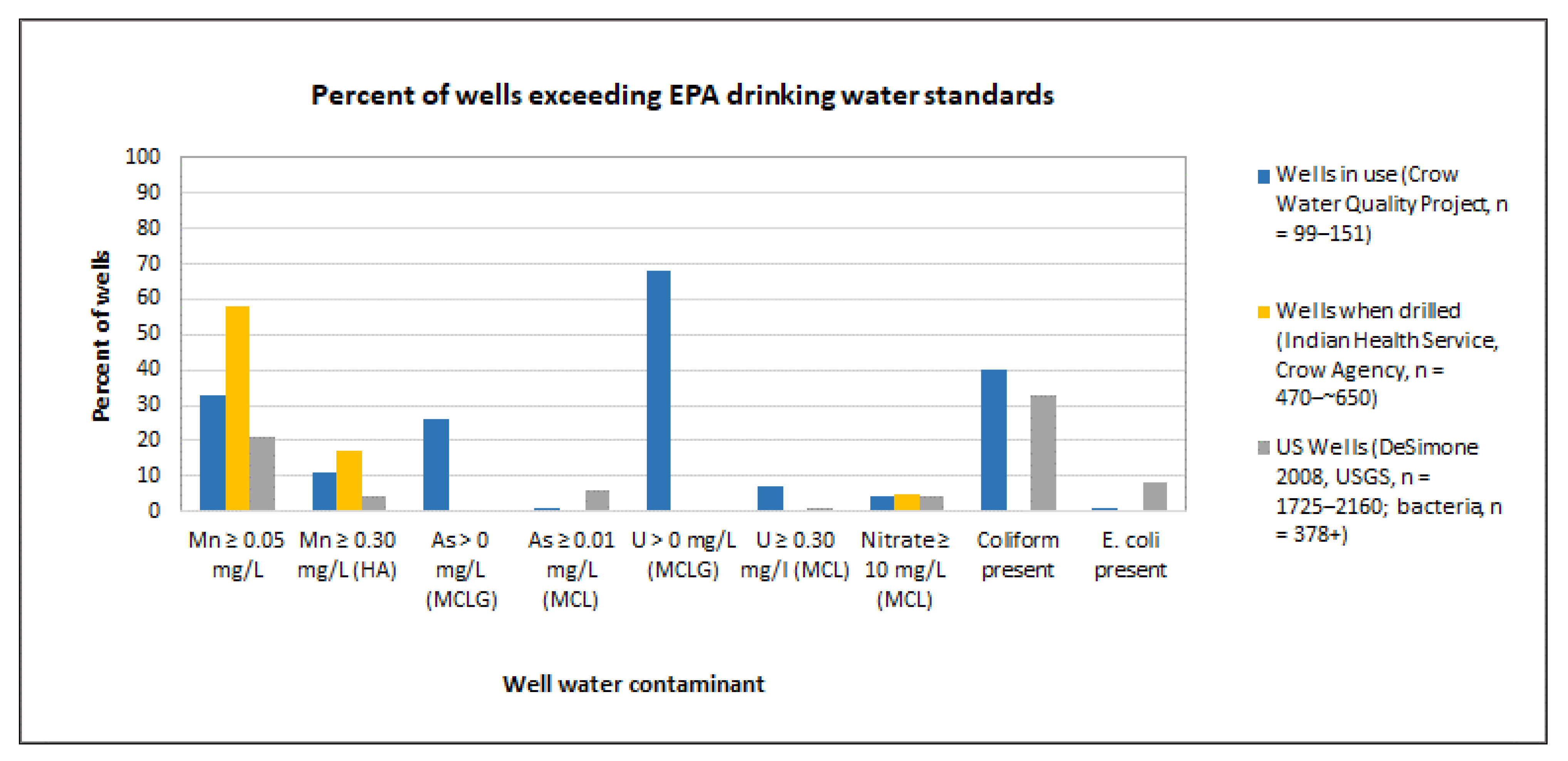
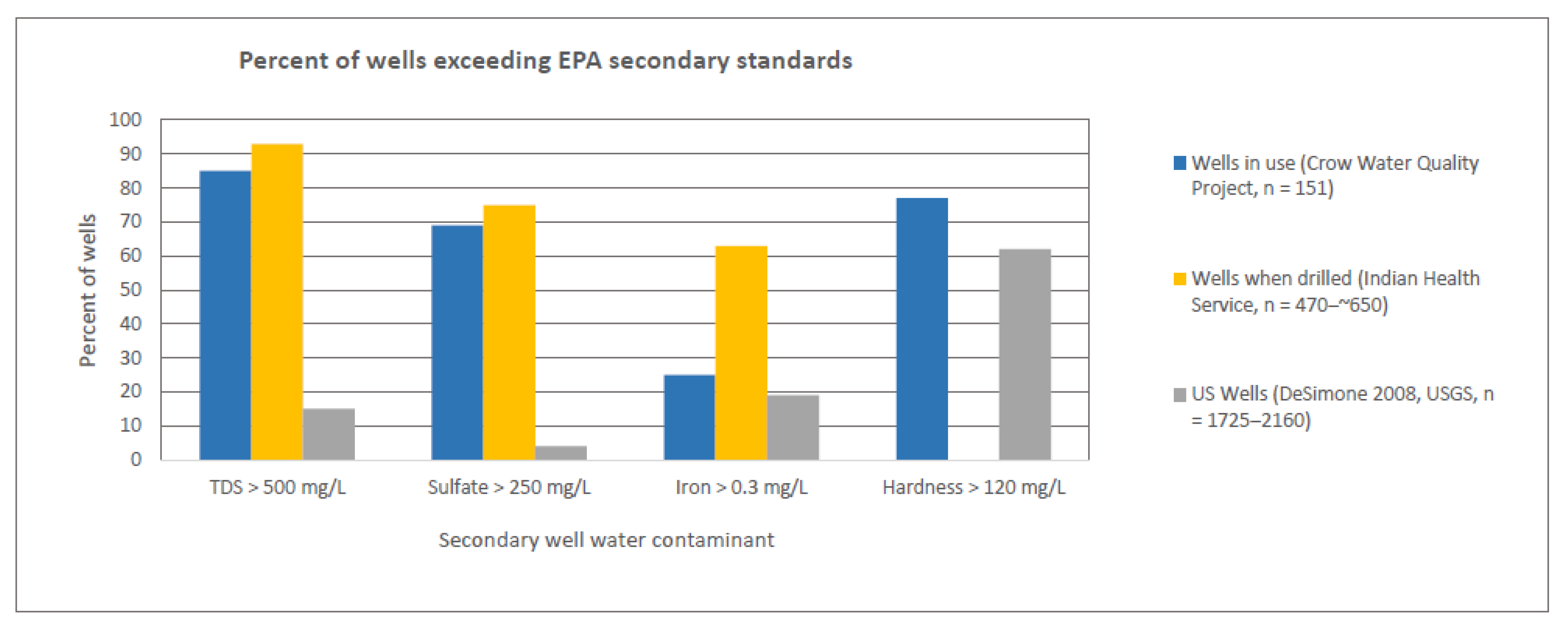
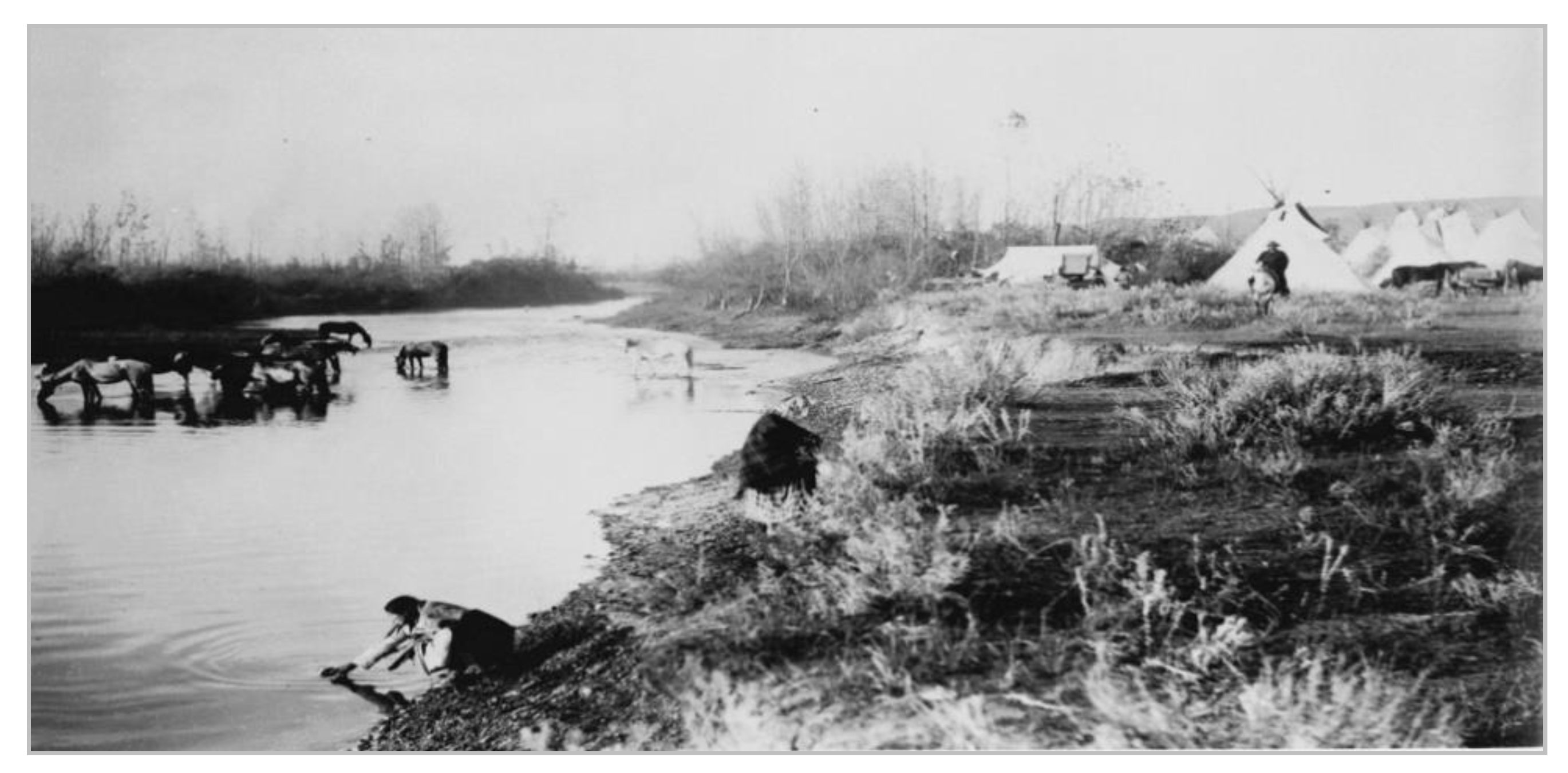
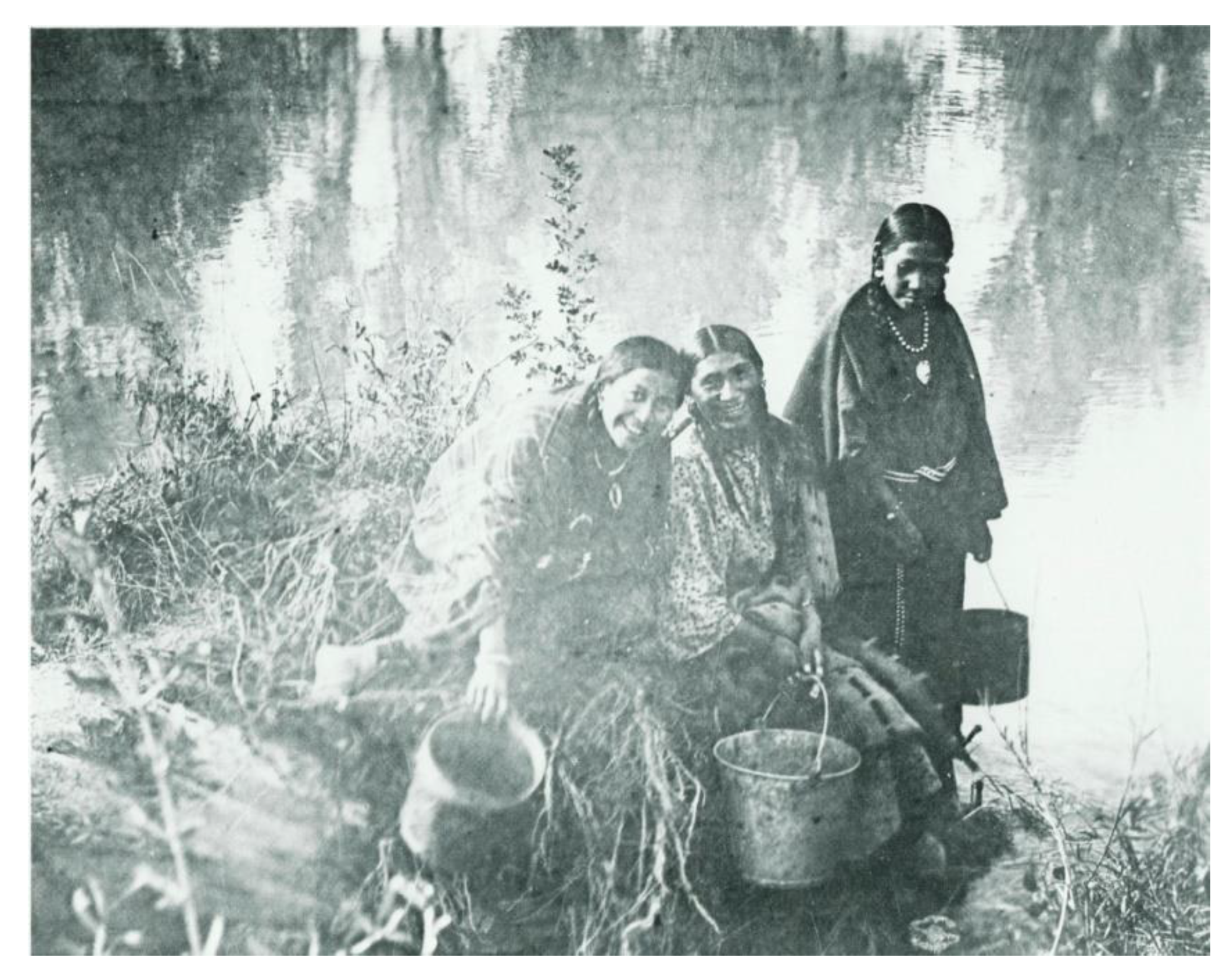
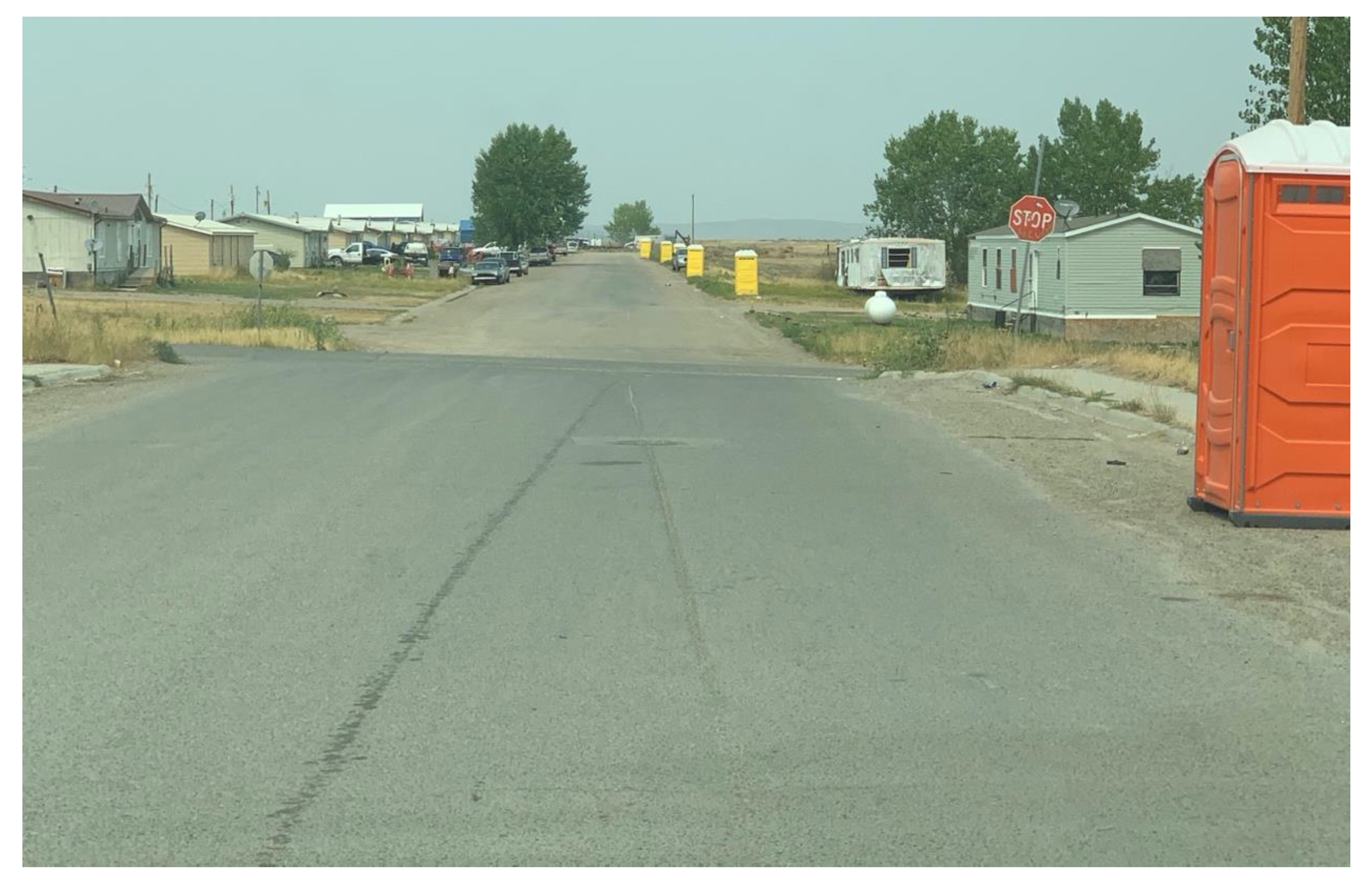
| Participant | Water Source | Drinkable | Amount of Water | How Often? | Cost of Water per Trip | Miles Roundtrip | Total Cost per Month |
|---|---|---|---|---|---|---|---|
| 1 | Well | Yes | 2.5 cases | Weekly | 15.00 | 200 | $520.00 |
| 2 | Cistern | * | 1000 gal | Monthly | 25.00 | 28 | $41.20 |
| 3 | * | * | 5–10 gal | Weekly | 12.00 | 80 | $232.00 |
| 4 | Cistern | * | 250 gal | Weekly | 50.00 | * | ** |
| 5 | Well | Yes | * | * | * | * | ** |
| 6 | Well | Yes | * | * | 30.00 | 140 | ** |
| 7 | Well | Yes | * | * | * | * | ** |
| 8 | Well | No | 5 gal | Weekly | 20.00 | 80 | $264.00 |
| 9 | Well | Yes | * | * | * | * | ** |
| 10 | Well | Yes | 10 gal | Weekly | 6.00 | * | ** |
| 11 | Well | No | 1 case | Weekly | * | 80 | ** |
| 12 | Well | Yes | 10 gal | Weekly | 6.00 | * | ** |
| 13 | Well | Yes | * | * | * | * | ** |
| 14 | Well | Yes | * | * | * | * | ** |
| 15 | Well | Yes | * | * | * | * | ** |
| 16 | Well | No | 4 cases | Weekly | * | * | ** |
| 17 | Well | No | Haul | Weekly | 60.00 | * | ** |
| 18 | Cistern | Yes | Haul | Weekly | 32.00 | 24 | $183.20 |
| 19 | City Water | * | * | * | * | * | ** |
| 20 | * | * | * | * | * | * | ** |
| 21 | Well | Yes | * | * | * | * | ** |
| 22 | City Water | * | * | * | * | * | ** |
| 23 | City Water | * | * | * | * | * | ** |
| 24 | Cistern | Yes | * | * | * | * | ** |
| 25 | Well | Yes | Haul | Monthly | 115.00 | * | ** |
| 26 | Well | No | * | Monthly | 50.00 | 80 | $96.00 |
| 27 | City Water | * | * | * | * | * | ** |
| 28 | Well | No | Haul | Weekly | * | 80 | ** |
| 29 | Well | Yes | * | * | * | * | ** |
| 30 | Well | No | 20 gal | Weekly | 100.00 | 50 | $515.00 |
| Theme | Brief Description of Theme |
|---|---|
| Water is Sacred | Traditional relationship and respect that Apsáalooke have with river and springs. |
| Causes of Change | Perception of causes of changes to water insecurity. For example, increases in population and agricultural use of local water has caused river water quality to worsen; the introduction of modern plumbing has caused Apsáalooke people to obtain their drinking water from the tap instead of going to the river or spring which changes the special relationship between people and their water sources. |
| Health Risks associated with Water Quality Changes | Perception of health risks associated with local water quality changes which impact water security. |
| Resulting Changes in Water Use (Sense of Loss) | Changes in the way Apsáalooke use water. For example, water for domestic and ceremonial uses coming from tap water instead of river water; not fishing in local rivers anymore. |
| Water Insecurity | Burdens associated with having to obtain enough safe water for household use. |
| Dealing with Water Insecurity | Actions or activities undertaken by Apsáalooke to address water insecurity. |
| Solutions are Hard to Find | Challenges people faced when working to address water insecurity. |
| Availability of Resources | Availability of resources in the community to address water insecurity. |
Publisher’s Note: MDPI stays neutral with regard to jurisdictional claims in published maps and institutional affiliations. |
© 2021 by the authors. Licensee MDPI, Basel, Switzerland. This article is an open access article distributed under the terms and conditions of the Creative Commons Attribution (CC BY) license (http://creativecommons.org/licenses/by/4.0/).
Share and Cite
Martin, C.; Simonds, V.W.; Young, S.L.; Doyle, J.; Lefthand, M.; Eggers, M.J. Our Relationship to Water and Experience of Water Insecurity among Apsáalooke (Crow Indian) People, Montana. Int. J. Environ. Res. Public Health 2021, 18, 582. https://doi.org/10.3390/ijerph18020582
Martin C, Simonds VW, Young SL, Doyle J, Lefthand M, Eggers MJ. Our Relationship to Water and Experience of Water Insecurity among Apsáalooke (Crow Indian) People, Montana. International Journal of Environmental Research and Public Health. 2021; 18(2):582. https://doi.org/10.3390/ijerph18020582
Chicago/Turabian StyleMartin, Christine, Vanessa W. Simonds, Sara L. Young, John Doyle, Myra Lefthand, and Margaret J. Eggers. 2021. "Our Relationship to Water and Experience of Water Insecurity among Apsáalooke (Crow Indian) People, Montana" International Journal of Environmental Research and Public Health 18, no. 2: 582. https://doi.org/10.3390/ijerph18020582
APA StyleMartin, C., Simonds, V. W., Young, S. L., Doyle, J., Lefthand, M., & Eggers, M. J. (2021). Our Relationship to Water and Experience of Water Insecurity among Apsáalooke (Crow Indian) People, Montana. International Journal of Environmental Research and Public Health, 18(2), 582. https://doi.org/10.3390/ijerph18020582






